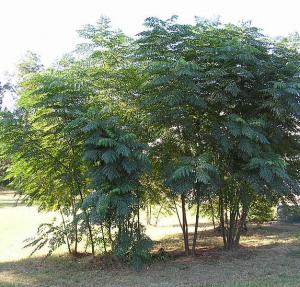Angelica Tree

Aralia spinosa (Devil's Walkingstick, Angelica-tree, Toothache Tree, Hercules' Club, Prickly Ash, Prickly Elder) is more of a giant perennial than a tree or shrub. It is primarily used as a decorative plant around walkways and patios. Considered to be invasive without regular maintenance Aralia spinosa can take quickly take areas over by way of sending up root stems into the surrounding area much in the same way running bamboo does. The plant is considered mildly toxic; specifically the roots, bark and berries. Fully developed, this plant can grow to 20 feet or more and have a few branches, more common are younger specimens with a single naked stem with cluster of leaves at the top.
Aralia spinosa contains a glucoside ‘Araliin’, and its history as a medicinal herb dates back to the early plains Indians who would consume the bark to induce vomiting, and make a bark derived tincture for the treatment of skin diseases and rheumatism. It was also used early in history for the treatment of syphilis. In tincture form, the berries have been used to sooth the pain of decayed teeth and in other parts of the body and as a strong laxative for constipation. Also a powerful sialogogue (causes salivation), parts of the plant have been dried and powdered for use in diseases where mouth and throat get dry, and for sore throat.
The raw berries are considered to be mildly toxic to animals if ingested, contact with the bark or roots can cause skin irritation, and ingesting the fresh bark will cause vomiting.
Professional veterinary treatment is rarely necessary as most pets will naturally make a full recovery. As with any plant or toxin that causes mild to severe diarrhea, dehydration can become an issue. Insure that your pet maintains and adequate intake of fluids. Prevent further ingestion of the plant and consult your veterinarian.
To alleviate the gastrointestinal upset and diarrhea Kapectolin may be given at a dose rate of 1 to 2 ml/kg four times a day. Kapectolin provides a coating action that protects the stomach lining. Sucralfate may also be used as for gastrointestinal irritation as it reacts with the acids in the stomach to form a paste-like material capable of acting as a barrier between the stomach and its contents. Sucralfate is typically given to dogs weighing more the 60lbs: 1g every 6 to 8 hours; for dogs under 60 lbs: 0.5g every 6 to 8 hours; Cats: 0.25g every 8 to 12 hours to reduce irritation of the stomach and intestines. With at home symptomatic and supportive care, the prognosis is good and in most cases symptoms will quickly begin to fade and within 1 to 2 days most pets will have made a full recovery.




